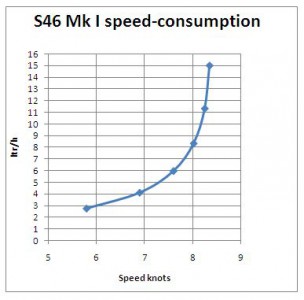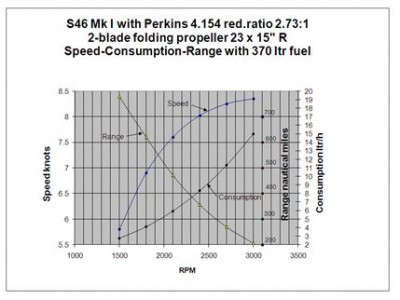New engine for Swan 46
Posted 15/04/2014: Foreign Affair New Engine
The engine was 18 years old with 4000 hours of use.
It was still running well but we would occasionally have a problem, and each time the problems appeared to get more serious and deeper into the engine.
The last problem was a year ago at the Middle Sea Race when we had to replace the fresh water pump, which required removing all the timing etc. So we decided to make a change, before we lost time in prime season.
We spent almost a year looking at and considering engines and reading all the helpful feedback on the www.swan46.org website. We eventually selected the Yanmar-4JH5E-LR, a 53HP equiv. I spent a lot of time agonising about the Starboard Access, but now the Yanmar is installed it is lower and can be accessed from Port – I will let you know how this works out.
The cost of the engine is one thing, the labour and parts, plus the opportunity to improve things, adds a lot more. I will let you know the approximate costs when I get the final bill.
Throughout this process, I have been supported by Laurent von Saenger of Strat-O-Sphere in Antibes who has maintained my boat from new in 1985, plus the amazing support from Lars our Technical Advisor, and all the helpful feedback from the swan46.org members – Thank You.
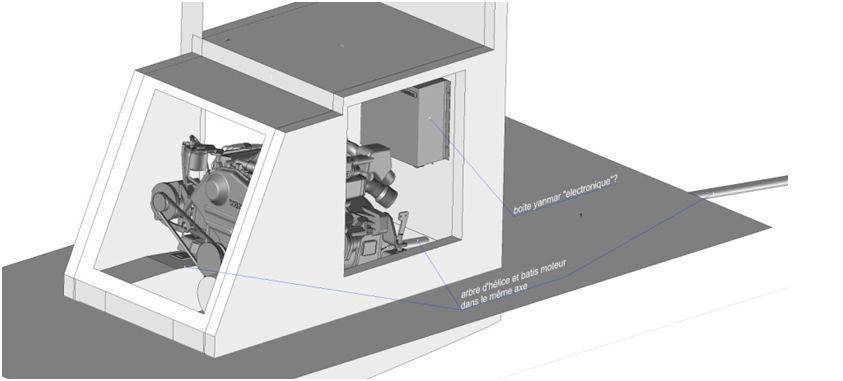
Engine room dimensions : the choice of the right engine depended also on the hatch and engine room dimensions.
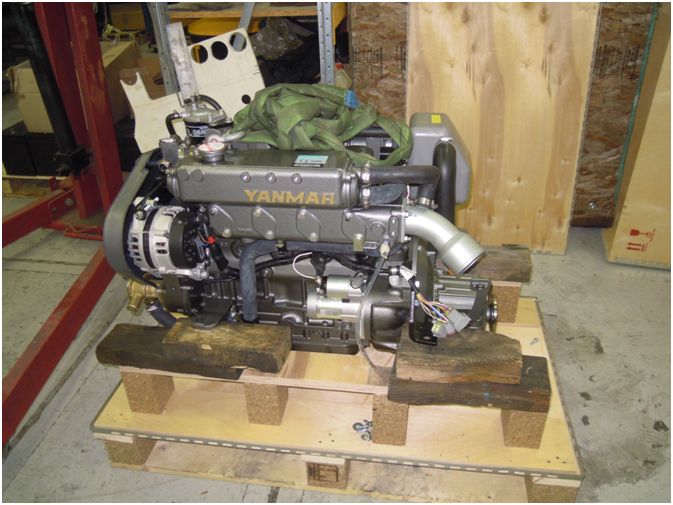
Yanmar-4JH5E-LR, a 53HP equiv.
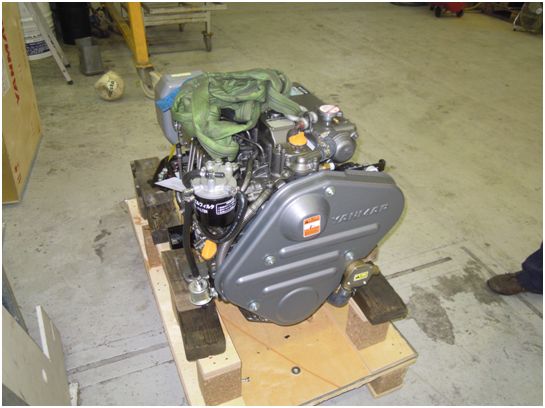
Receiving the engine at the work shop gave us the opportunity to check all the necessary diameters and dimensions of the fitting prior to installing.

Taking away the old engine has been made with Foreign Affair moored in the shipyard of Cap d’Ail (easier to store the old engine).
Thank you to Bertrand Cohen and the Fontvieille capitainery staff who trailed the boat back with no engine.

A specially designed water lock was made and positioned inside the engine room above the inverter. The total exhaust line was also replaced from an old 50 mm tube to a new 60 mm one, thus reducing the loss of pressure compared to the former installation.

The new support for the service alternator and belt driven water maker pumps has been made in fiberglass. An stress simulation was carried on the computer to make sure the thickness is “at the right place” and to keep the deformation under load to an acceptable level.

The pulley driving the service alternator and watermaker belts has been modified to fit against the main pulley of the new engine.
The link between the reduction gearbox and the big Nautor propeller shaft (38.1 mm) has been modified also.

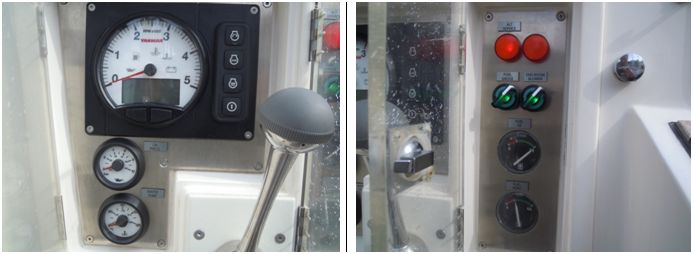
To install the new Yanmar control and display, it was necessary to reorganise and simplify the starboard part of the cockpit.
New stainless steel plates were cut and installed on threaded inside frames. This allows us to dismount and remount the plate as often as needed.
A new throttle lever and new low friction “Maxflex Pinnacle” wires connecting the reduction gearbox were also installed.
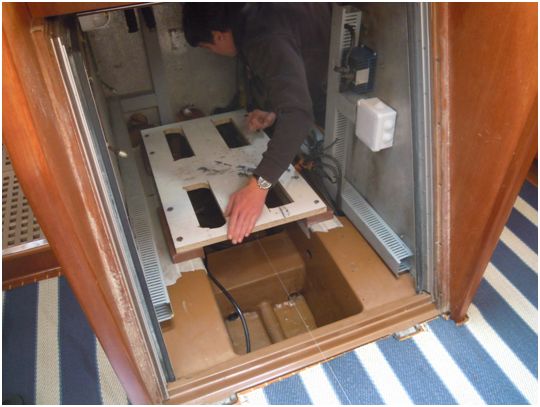
Knowing the existing axis position of the propeller shaft, enabled us to prepare the new supports at the work shop, and to install them at the right place before installing the new engine (on the photo Matthieu is positioning the template to locate the supports).
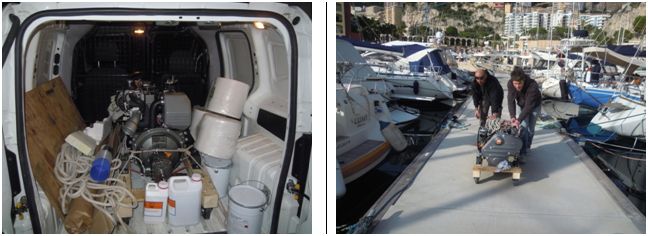
Delivering the new engine was made while Foreign Affair was back in her birth in Fontvieille.

Installing a new engine, with known dimensions, was easier than taking out the old one, and were able to do with double Halliards.
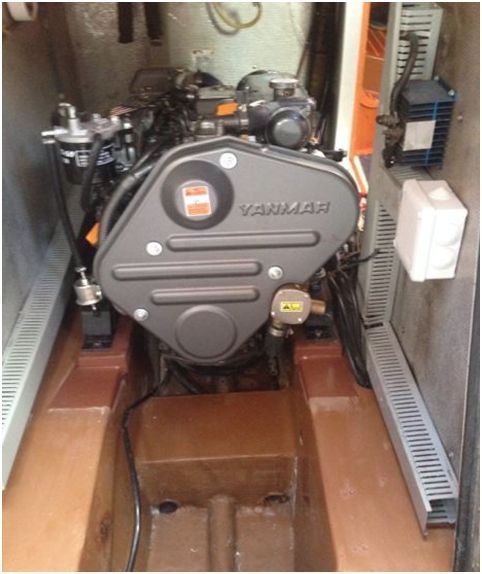
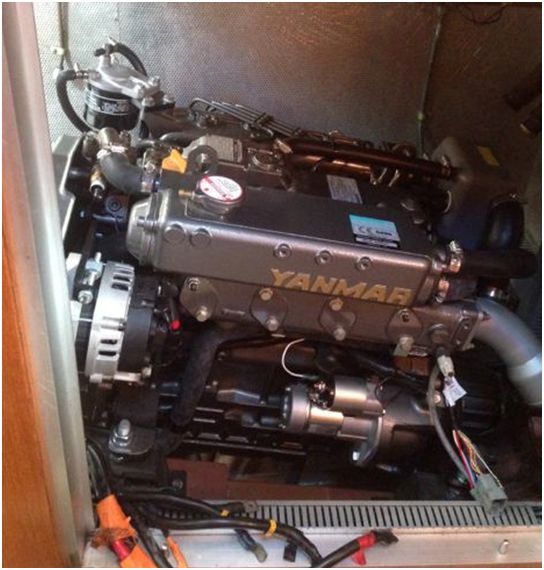
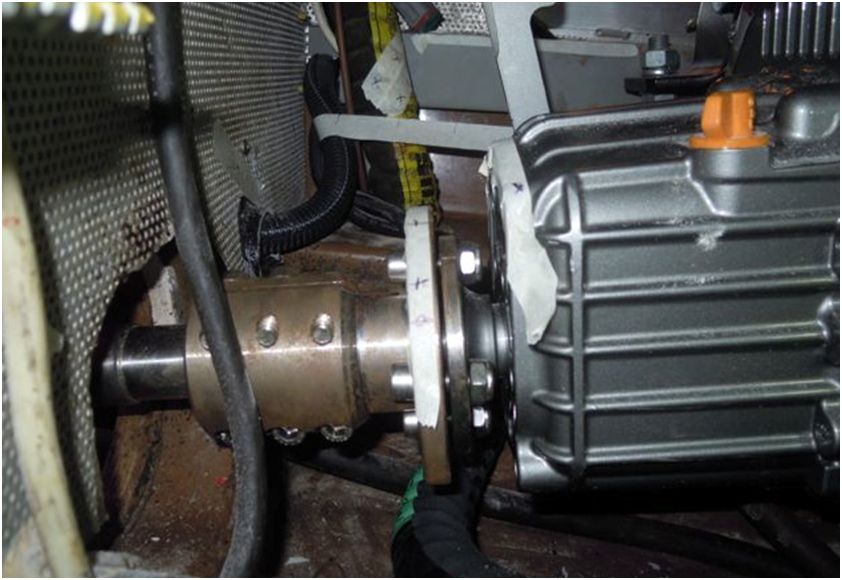
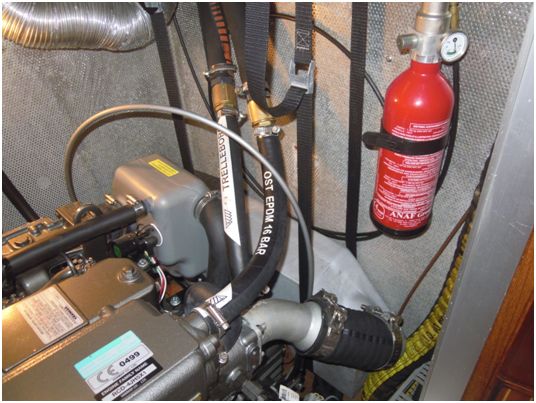
A newly installed lamp allows us now to have a clear view of the aft and starboard side of the engine room.
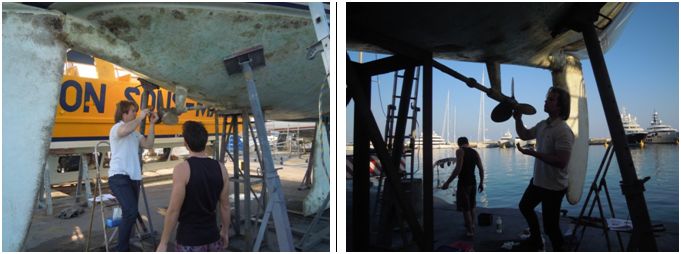
Choosing the right propeller pitch for the new installation is a hard choice. Beyond theoretical calculations, it also depends on the level of preparation of the hull bottom, and on the amount of power requested by the belt driven auxiliary equipment.
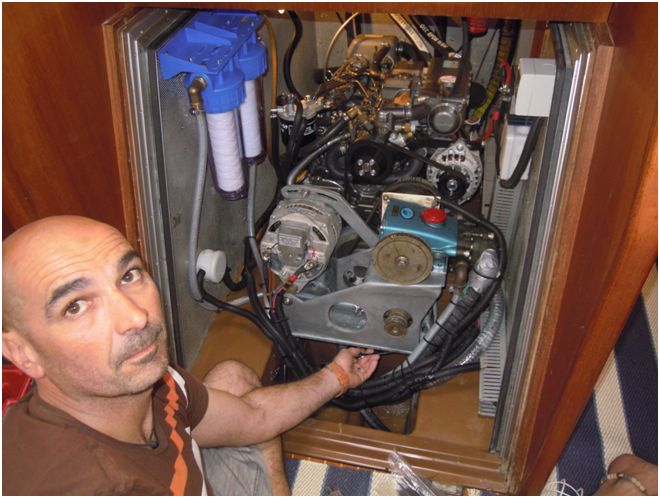
Alex Palusci has been the central operator throughout the installation, assuring the maximum reliability in each step of the work.
*** *** *** *** *** *** *** *** *** *** *** *** *** *** *** *** *** *** *** *** *** *** *** *** *** *** *** *** *** *** *** ***
Posted 29/05/2013: We are swapping our original Perkins 65 for a bright new shinny Volvo 55. RORC rating want to know the weight of the Perkins, does anyone know?
Hope to see some of you in Cowes in July! Andy
*** *** *** *** *** *** *** *** *** *** *** *** *** *** *** *** *** *** *** *** *** *** *** *** *** *** *** *** *** *** *** ***
I went to the Trans Atlantic Diesels shop yesterday to look at Cummings engine. It offers port side access and service as well as more power, (from 3.3l engine) but I think it is just a bit too big for good overall access. Going back to look at Yanmar. Our boats have particular mounting problems with high mounting beds and access through the main companionway can be a challenge. Does anyone know if it is possible to remove the cabinetry behind the main companion way stairs? Just removing the triangular shelf would be a big help in dropping the motor down. Posted by Katface
*** *** *** *** *** *** *** *** *** *** *** *** *** *** *** *** *** *** *** *** *** *** *** *** *** *** *** *** *** *** *** ***
Swan 46, has had engine failure with the original Perkins 4-154. I have three engines I am looking at now.
The first is a Cummins with port access. The configuration and power output appear to be very good matches but this engine is only available with 12V components. Volvo B2-55 and the Yanmar engines in this HP range (4JHE-TE and 4JH5E) all have the fuel side on the starboard side. I assume they are available in 24V versions. Can you help me contact the other owners mentioned to see how they addressed the access and exhaust routing accommodations? Do they find any issues with access for service with these engines or can they get to the oil, water, and fuel service locations adequately? Has anyone tried to use a 12V engine? I am trying to decide which is the most important problem to solve, the lack of access or the 12V to 24V conversion issues. Any advice from others who have dealt with these issues would be most valuable. What were the major issues each experienced?
Here are some initial questions. I have studied the thread on the website fairly extensively.
The first problem is how much power is required. The current engine is rated at 63 hp with the Yanmar and Volvo normally aspirated engines at about 55 hp. I have read the thread on the website and the implication seems to be that for the cruising we plan this could be the right choice. I say this because my prejudice because range is more important than overall top speed. That said I am somewhat worried/scared about going to a less powerful solution so I am interested in how you and others have made this trade. So far Swan 46 owners have selected the Volvo 55 hp engine and the Yanmar 75 hp turbo. I know of a boat in California that went to the 100 hp version of the Yanmar but that seems excessive. Any other motors that should be considered? I looked at the Beta and Nanni briefly – they appear to be higher speed than optimal. There is also a local vendor making a version of a Cummings Marine engine that is a very close drop in for the Perkins 4-154 but i worry about getting parts internationally.
Second problem is the 2 inch/50 cm ID of the exhaust coming off the PE250 Bowman manifold. Have you and others had to completely re-route the exhaust due to the need for a greater exhaust diameter? What is the effect on the routing of the exchange system for the hot water heater, etc?
Third, as you point out, the Yanmar and Volvo engines appear to have the exhaust on the port side, not the starboard. How much trouble is access for servicing? Any bleeding issues with the fuel system, or access to the water pump, etc that others have run across? My boat does have a large hatch in the aft head that allows starboard access to the engine but it is not as good as removing the entire port side cover. Last, but not least, did others re-route the exhaust on the other side or cross over before the muffler assembly, or?
Fourth, the 24 volt system seems to be a major problem. Did others move to a 12 volt starter, etc and then use a 24 volt alternator or were they successful in finding a 24 volt engine? How much trouble was any conversion?
I have already pulled the head off the current Perkins so I can run any performance tests with the current engine. Both the head and exhaust manifold require replacement to make the engine work so that is not an option. Transmission is HDW with 1:2.74 gear ratio and 3 blade max-prop propeller. I have not started to get my arms around the transmission selection or even the absolute need to replace the existing gearbox. Advice/things to avoid in this area would also be very helpful.
We are novices at this without an extensive sailing background. All information is helpful and we acknowledge it is our job to sort it out.
I am looking to re-powering rather than rebuilding and wanted to solicit information from the group. Posted by Katface
*** *** *** *** *** *** *** *** *** *** *** *** *** *** *** *** *** *** *** *** *** *** *** *** *** *** *** *** *** *** *** ***
Replacement Engine for Foreign Affair.
Cummins 4B3.3M has replaced Perkins 4.154 in many cases, said to fit in the same space. The Solé diesel based on Mitsubishi appears to use port side for some models. On the other hand it would not be a big job to make an access hatch in the aft head. When you have decided which engine to use I could assist with choosing a suitable reduction ratio. Lars
It’s time to replace my engine, after 17 years. We concluded that the Perkins was the only engine suitable with maintenance on the port side, so though that was the best solution. However, I now understand that The Perkins brand no longer supplies a replacement engine. We have found the Lombardini brand, supplying an engine pretty much like the Yanmar one but with maintenance on starboard side. Do you know of a suitable engine with maintenance on the Port side? Foreign Affair
*** *** *** *** *** *** *** *** *** *** *** *** *** *** *** *** *** *** *** *** *** *** *** *** *** *** *** *** *** *** *** ***
We own Hull #38 and over our ownership of 22 yrs. and considerable milage, I very much like the color Blue for the engine. (Blue means Perkins and reliability). Now with that said, I have seen several 46’s with new engines and in almost all cases it’s been a BIG job. Some have opted for light weight and high RPM and others for larger HP (120) if you can believe it. Several issues “erupted” for the larger HP. Larger exhaust which meant expanding the exit in the transom and now the possibility of water ingress when hit by a large wave from the stern, tendency to crank up the RPM which means higher fuel consumption, changing all fuel lines and ultimately breaking the shaft when trying to get over 9kts. Our 46 (Bandit) has a Perkins 4156 (56HP) and although there are times when a little more juice would be helpful, this seems to be the correct HP/weight and fuel consumption. I have about 9000 hrs. on her and like a delicate woman—–treated like gold. Recently, I did have an issue with the fuel pump gasket and had the opportunity to secure a very reliable Perkins trained mechanic for the repair. I did have a chance to discuss all the “what-if’s” with the 4156 and the conclusion was to continue regular maintenance and if necessary have it re-built. According to my mechanic most new engines are OK, but not built like the old Perkins. He did also say, if the Perkins was a wreck then Yanmar would be a good choice. They are installed in many new boats and have proven reliable—just have to get used to the higher RPM. Cheers, Fred Davies
*** *** *** *** *** *** *** *** *** *** *** *** *** *** *** *** *** *** *** *** *** *** *** *** *** *** *** *** *** *** *** ***
A few comments on the choice of engine power. Some engine models are upgraded from the standard version by increasing the maximum rpm. Such engines are not recommended for sailing yachts, as it is necessary to use a higher rpm than with the standard engine for the same cruising speed. The increased power is available only at rpms exceeding the standard engine maximum. Dealers may suggest choosing a big engine “just to be sure there is enough hp”, but it should be noted that some engine manufacturers strongly advise against running engines at low load, and specifically recommend using high engine outputs. They also may describe how to clean out the soot accumulated during spells of low load. Therefore it may not be a good idea to choose a very powerful engine as this probably also requires a high minimum cruising speed in order to keep the engine clean. It is suggested that you ask for the opportunity to read the Engine Operating Manual on this point before deciding on engine power, and get confirmation what the minimum recommended continuous output is. I would be interested to hear what dealers/manufacturers say about this minimum output. The cruising speed can be used as a reference for the choice of engine power, and this approach is suggested here. Marine engines are built for working fairly hard, and need to be loaded to at least 25% output in continuous use, otherwise they will collect a lot of soot, and are likely to suffer from this. On the other hand the maximum continuous output is generally 75% of the full power. There may be differences in this respect between engine manufacturers.
Below are three cruising speed estimations made specifically for Swan 46. The propeller type and size is likely to affect them slightly.
50 hp engine 25% output 75% output
Speed 6.2 knots 8.1 knots
Consumption 3.2 ltr/h 9.7 ltr/h
75 hp engine
Speed 7.2 knots 8.3 knots
Consumption 4.8 ltr/h 14.6 ltr/h
100 hp engine
Speed 7.7 knots 8.4 knots
Consumption 6.4 ltr/h 19.4 ltr/h
In terms of engine rpm the 25% output corresponds to about 60% of the maximum rpm, and 75% output to 90%. For example for a 3000 rpm engine this is 1800 and 2700 rpm. It should be noted that the relation between rpm and power is not linear. This is caused by the propeller law, which in a very autocratic way determines how much power is absorbed by the propeller, and transmitted into thrust.
Fuel consumption goes up very steeply near the top speed, and it is certainly advisable to reduce speed a little if consumption is of concern. This figure shows that by dropping the speed half a knot from the maximum reduces consumption by one half. This is a general rule for yachts of this type.
Here below also the Speed-Consumption Range diagram for the original engine and folding propeller. I guess most 46’s now have other engines and propellers, meaning that this diagram does not refer any more.
Such a diagram is helpful when planning longer trips under power.
If you would like to have a valid diagram for your own yacht I could do this as a pro bono favour for the Association members, but pls note that the following information is required from you:
– Measured rpm-speed values in calm and deep water. 6 values needed about equally spaced, including full throttle.
– Engine model, preferably with a technical specification, reduction gear ratio, propeller type, diameter, pitch, number of blades, right or left handed, total fuel capacity.
– If you have measured fuel consumption information this is of interest, but not necessary
For the members planning engine replacement advice is available on choice of reduction ratio, propeller type and dimensions.
I will comment separately on the feedback recently provided by members in the maintenance section. These things are complicated, and your questions and comments are welcome. Kind regards, Lars
*** *** *** *** *** *** *** *** *** *** *** *** *** *** *** *** *** *** *** *** *** *** *** *** *** *** *** *** *** *** *** ***
Dear Sven, here is a comment to the information you kindly provided. Please note that you are free to decide whether to proceed or not. Best regards, Lars. Water in the exhaust suggests that either the siphon break in the cooling water circuit has a problem, the exhaust hose routing aft needs to be improved, or the waterlock is too far to the side. Is there a drain cock in the waterlock?
In 2010 the old Perkins diesel was replaced after water had managed to run back through the exhaust. At the time the choice fell on a roughly 60hp Yanmar diesel. The choice fell for the non-turbocharged engine in order to have a low revving engine with sufficient torque for the Max-Prop 3-blade propeller that was installed at the same time. What I can say is that no issues have surfaced with the engine and that it has been running some 500h until now. With the engine running at some 1600-1700 revs I can run some 6,5kn with a consumption of less than 3l/h diesel.The Yanmar is said to be slightly higher in vibration than the Volvo Penta but at normal cruising speed I have no complaints. My next task this winter will be to improve the sound deadening as I feel this could be better. Also the oil filter is on the reverse side of the engine bay that you cannot access by taking a panel away. Also this winter I will replace the old stuffing box with a modern water lubricated system to get a drip free life. Cheers, Sven
*** *** *** *** *** *** *** *** *** *** *** *** *** *** *** *** *** *** *** *** *** *** *** *** *** *** *** *** *** *** *** ***
Dear Michael, here is a comment to the information you kindly provided. Please note that you are free to decide whether to proceed or not. Best regards, Lars. If your Nanni engine has a nominal top rpm of 2800 (assumed, I do not know which model) and achieves maximum 2400 this means that the propeller has too much pitch, and the engine does not develop full power. If there is a Max-Prop the pitch can be adjusted.This should increase the top speed to over 8 knots provided the propeller has a sufficient diameter. If you provide the installation particulars I could give a pitch recommendation.
Twilight has a new engine Nanni Kubota 62 HP. An excellent engine which was installed in 2004. I kept the 2 blade prop but I’m now considering to replace it by a 3 blade max prop as this will push speed up to 8 knots. Engine runs at 2000 rpm at cruising speed and can be pushed to 2200 – 2400 rpm when needed. The support of the engine should fit on the reinforced part of the frame of the engine. The bolts of the supports need to sit close where the old supports sat. If not the bolts are tightened in a zone with less thickness. We had this problem at one support and we had to make an opening at the side of the frame to fit a metal plate and a counter screw. Regards, Michael
*** *** *** *** *** *** *** *** *** *** *** *** *** *** *** *** *** *** *** *** *** *** *** *** *** *** *** *** *** *** *** ***
Dear Adriaan, here is a comment to the information you kindly provided. Please note that you are free to decide whether to proceed or not. Best regards, Lars. The top rpm for Nanni 5.280HE is 2800 rpm. If the engine achieves max 2400 rpm it sounds like there is too much pitch, unless the engine specification allows a lower full throttle rpm.
In my Swan 46 Mark I the original engine was replaced in 2002 by a Nanni 65 hp, type 5280HE. The propeller is a Maxprop with a diameter of 58 cm. Cruising speed is 7 knots with 1800 rpm, topspeed over 8 knots with 2400 rpm. So far I have had no problems with this engine. Kind regards, Adriaan Holm, Taika 46-025
*** *** *** *** *** *** *** *** *** *** *** *** *** *** *** *** *** *** *** *** *** *** *** *** *** *** *** *** *** *** *** ***
Dear Fred, here is a comment to the information you kindly provided. Please note that you are free to decide whether to proceed or not. Best regards, Lars. Very interesting comments about the replacement engines. Pls check the latest trends, rpms are slowly coming down for engines intended for sailing yachts. If you do not have the original speed diagram it can be found in my previous reply.
We own Hull #38 and over our ownership of 22 yrs. and considerable milage, I very much like the color Blue for the engine. (Blue means Perkins andreliability). Now with that said, I have seen several 46’s with new engines and in almost all cases it’s been a BIG job. Some have opted for light weight and high RPM and others for larger HP (120) if you can believe it. Several issues “erupted” for the larger HP. Larger exhaust which meant expanding the exit in the transom and now the possibility of water ingress when hit by a large wave from the stern, tendency to crank up the RPM which means higher fuel consumption, changing all fuel lines and ultimately breaking the shaft when trying to get over 9kts.
Our 46 (Bandit) has a Perkins 4156 (56HP) and although there are times when a little more juice would be helpful, this seems to be the correct HP/weight and fuel consumption. I have about 9000 hrs. on her and like a delicate woman—–treated like gold. Recently, I did have an issue with the fuel pump gasket and had the opportunity to secure a very reliable Perkins trained mechanic for the repair. I did have a chance to discuss all the “what-if’s” with the 4156 and the conclusion was to continue regular maintenance and if necessary have it re-built. According to my mechanic most new engines are OK, but not built like the old Perkins. He did also say, if the Perkins was a wreck then Yanmar would be a good choice. They are installed in many new boats and have proven reliable—just have to get used to the higher RPM. Cheers, Fred Davies
*** *** *** *** *** *** *** *** *** *** *** *** *** *** *** *** *** *** *** *** *** *** *** *** *** *** *** *** *** *** *** ***
Dear Joost, here is a comment to the information you kindly provided. Please note that you are free to decide whether to proceed or not. Best regards, Lars. This is an unusual setup. Above it was suggested that there is too much pitch, but here it appears to be the opposite. Top speed 7.8 knots indicates that the propeller uses about half of the engine maximum power, and calculation shows that with the yacht stationary such a propeller does not use full engine power. If you are aiming at maximum thrust at low speeds more pitch would be advantageous. If you are content with the situation that’s fine with me, but I would suggest improvement is possible.
I have replaced my old Perkins with a Volvo Penta D 2-55, which suits the tonnage and the hull form well. The engine is running smoothly with very little noise. Speed can indeed easily go up to 8.5 knt, which depends the pitch of the propeller blades. My experience is that most maintenance people know very little about calculating the parameters for the right propeller and the right pitch, when you change engine. I engaged an advisor on this too late. After getting to the right propeller the fine tuning of the pitch is a matter of choice between speed and forward power against waves. I decided for the latter and have a max speed of 7.8 knt, which I rarely reach, as the fuel consumption goes up dramatically when you go over 2300- 2500 rpm. This is something to reckon with, when you have to cover a long distance without enough wind. The Volvo D2-55 was offered to me for E 12.776,- ex Vat. The total cost of engine plus labour was offered at E 21.265. Including additional work on unforeseen problems it came to around E 25.000 ex Vat. Work was done by Nautor Benelux in IJmuiden the Netherlands and was done well. I hope that this is of any help to you. Best regards, Joost
*** *** *** *** *** *** *** *** *** *** *** *** *** *** *** *** *** *** *** *** *** *** *** *** *** *** *** *** *** *** *** ***
I replaced mine 5 years ago with Yanmar 75 turbo, so far so good, Touching wood! It was one of the 2 suggested by Lars. It is a very very good engine, I run all my utilities with it. Watermaker, fridge freezer, 110 v 24v alternator at very low rev max 1200. First thing you notice is that is not burning oil, never needed to add oil before the service. Also consumptions is lower then a Volvo same cc as we did a comparison with another 46 mkI during a delivery to las palmas. For my experience Yanmar is a very very good choice with a mechanic ZF gear box and 3 blade maxprop. Posted by Milanto.
*** *** *** *** *** *** *** *** *** *** *** *** *** *** *** *** *** *** *** *** *** *** *** *** *** *** *** *** *** *** *** ***
Engine replacement – I think it’s time to replace the engine on my 46 MKII. I currently have a Perkins 50hp, it has served me well for 17 years. However some recent reliability problems have me thinking of replacement. I have noted Lars feedback below. Has anyone replaced their engine?
If so, with what? What advice can they offer? Regards, Paul
Please reply to: paul.basson@monaco.mc
*** *** *** *** *** *** *** *** *** *** *** *** *** *** *** *** *** *** *** *** *** *** *** *** *** *** *** *** *** *** *** ***
For example Volvo D2-55 or -75 would be suitable due to the low maximum rpm. There are also other brands with similar characteristics. With 55 hp and the right propeller the top speed should be close to 8½ knots. The speed will increase very little with additional hp. If you increase the power it is advisable to check the propeller shaft strength. Regards, Lars Ström.
*** *** *** *** *** *** *** *** *** *** *** *** *** *** *** *** *** *** *** *** *** *** *** *** *** *** *** *** *** *** *** ***
We have a Swan 46 MKI with the original Perkins engine. Can somebody recommend a suitable modern replacement engine?
Please reply to Jonathan Bailey: jbailey@clipper-ventures.com


